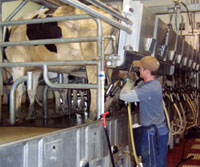Study finds dairy farming a satisfying profession — on farms big and small
What type of dairy farmer would you expect to be more satisfied with life?

One who owns a large confinement farm, milks hundreds of cows, raises hundreds of acres of row crops, hires many employees and invests heavily in field equipment, feed storage and waste management?
Or one who milks fewer than 100 cows and feeds them in large part on carefully managed pasture, moving them as often as twice a day, relying mostly on family labor and investing considerably less in equipment and facilities?
It turns out that both answers are right. Farmers who follow either of these divergent paths in modern dairy farming are equally satisfied with the quality of their lives. And they are more satisfied than those who operate smaller confinement farms or less intensive grazing operations, according to a survey of 1,300 Wisconsin dairy farmers by University of Wisconsin–Madison researchers.
Farmers who use different farming systems do differ somewhat in how they evaluate their own satisfaction, but not in the ways some might expect, according to the survey.
Managed graziers place more importance on hard-to-measure dimensions of life, such as opportunities for new challenges and creativity. Large confinement operators also valued such intangibles, but they gave similar weight to measurable achievements such as income, yields and property.
"Managed graziers are less concerned about material matters. They are more concerned with process and the harder-to-define aspects of what makes someone happy and prosperous in the fullest sense," says rural sociologist Michael Bell, a co-author of the study.
"But those things are also very important to the large-confinement farmers," he adds. "For both groups, satisfaction is about more than material things. It’s not just about money. That may surprise some people (who) assume that (operators of large farms) are just motivated by material kinds of things. That did not show up in our survey."
The researchers learned this by providing a list of various activities and experiences — such as earning money, being creative, having outside interests, providing jobs and being a steward of the land — and asking respondents to numerically rate how important they found each to be.
The results do not explain why those operating large-confinement and managed grazing farms express more satisfaction than those operating smaller confinement or less intensive grazing operations. But based on what they heard from focus groups, the authors suspect that the greater satisfaction has to do with the activity of creating something new and different.
"You get the feeling that they are on the trajectory of positive change," says Sarah Lloyd, a research assistant on the project. "They’re making a change; they’re actively engaged in making their operations successful."
In contrast, she says, those with non-intensive pasture operations and small confinement operations may be farming much as their parents did and may feel stuck as input costs go up and milk prices fluctuate.
Both large-confinement and managed-grazing operators also have the support of organizations that are geared toward their type of farming, adds Lloyd.
"Graziers have grazing networks. Large confinement operators have organizations like Professional Dairy Producers of Wisconsin. They’re getting positive feedback from these groups. I think that’s part of satisfaction," she notes.
Understanding dairy farmers’ life satisfaction is important – both for the farmers themselves and for policymakers – when making decisions about farming and farm systems, the researchers write in a report on their findings.
"Without offering a satisfying life, even the most profitable and ecologically sound forms of agriculture will not be sustainable," they write.
The report, called "Milking More Than Profit: Life Satisfaction on Wisconsin Dairy Farms," is published by the UW-Madison Center for Integrated Agricultural Studies.
Tags: agriculture, business




